THE GRAND WAZOO: THE BIG BAND
"Waka-Jawaka" and "The grand wazoo" were recorded during the same sessions. For "Waka/Jawaka" the set-up of the band is mostly like a smaller jazz combo. That this album can occasionally sound as a big band nevertheless is due to the frequent overdubbing. Sal Marquez for instance gets credited for "many trumpets" during "Big swifty". "The grand wazoo" can be more truly using a big band, a band with which Zappa also made a short tour. In full the band ultimately involved twenty members. Both 1972 jazz albums have extended solos as well as large composed sections. Several blocks are relatively stable in their use of keys. More like "King Kong" than the modernistic "Uncle Meat main title" and the "It must be a camel" examples from the preceding sections. "For Calvin" on the other hand is very versatile. Despite of the quality of these albums, Zappa has not become well known as a jazz arranger.
1. For Calvin
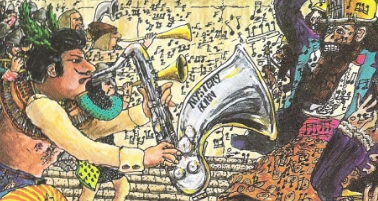 "The grand wazoo" opens with "For Calvin", a gentle melody in 12/8. The same meter appears in "Your mouth" from the previous section. The element
of improvisation is handled differently in both songs. "For Calvin" begins with the main theme, prescribed for all, returning at the end.
In between there's an interesting experimental improvisation block and a modernistic second composed block. "Your mouth" has just the lead melody prescribed,
lasting all through. There's no improvisation block in this song, but the instruments are playing freely around the lead melody. The Calvin from the track title
is Calvin Schenkel who drew the album front and back cover. Two outtakes are included in this section. It illustrates Zappa's leaflet story about an army of instruments players
attacking another army of singers with notes. The emperor Cleetus (track 3) leads the brass players, blowing a mystery horn.
"The grand wazoo" opens with "For Calvin", a gentle melody in 12/8. The same meter appears in "Your mouth" from the previous section. The element
of improvisation is handled differently in both songs. "For Calvin" begins with the main theme, prescribed for all, returning at the end.
In between there's an interesting experimental improvisation block and a modernistic second composed block. "Your mouth" has just the lead melody prescribed,
lasting all through. There's no improvisation block in this song, but the instruments are playing freely around the lead melody. The Calvin from the track title
is Calvin Schenkel who drew the album front and back cover. Two outtakes are included in this section. It illustrates Zappa's leaflet story about an army of instruments players
attacking another army of singers with notes. The emperor Cleetus (track 3) leads the brass players, blowing a mystery horn.
For Calvin, opening (midi file).
For Calvin, opening (transcription).
"For Calvin" is very flexible in its use of scales. The first five instrumental opening bars
don't follow a regular scale at all, the last transcribed bar 6 is in E. In between the key note floats and the scales keep changing.
"Your mouth" is more stable in this aspect, staying in C Dorian.
For Calvin, opening (score).
I included this example in 2005, but later on I came across samples from the original score. First this shows that Zappa had notated this
piece in 3/4 with one of my 12/8 bars coinciding with four bars in 3/4. Secondly the harmonies of my bar 1, played twice, were originally written
as wider:
Audible on record:
- descant melody: C-B-G#-E. The last E is part of a chord with also a
C# and B.
- lower melody: D-C-A-B.
- bass: G#-F#-E-A.
- harmonic fill in: B and E.
Present in the score, but not (fully) audible on record:
- trombone #3: Ab-E-C#-A.
- keyboard: arpeggio chords, each played for two bars, subsequently A-Ab-B-C-E and A-A-B-C#-E.
Such divergence between the written scores and the album recordings happens all the time. The Uncle Meat section gives an overview.
I can't tell what the whole original score would be like, whether now audible parts replaced written parts or whether parts got skipped. It does make clear that
the opening is harmonically complicated. The whole is chromatic, but there are fragments of diatonic material to be discerned in individual parts.
It is clear that the keyboard part got largely skipped. Not only for the opening bars (reduced to B-E), but also when the first theme begins.
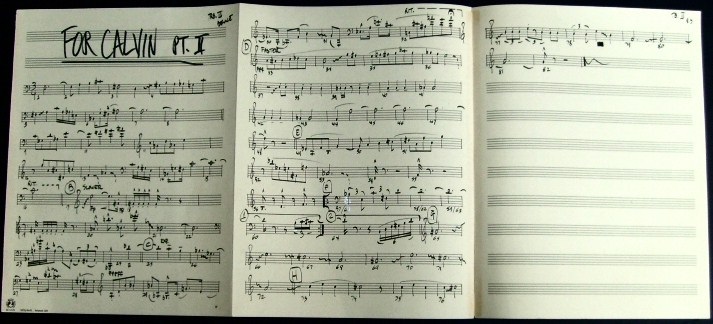
In the score the theme from above is referred to as part I. The screenshot here above is from the trombone #3 part of the second composed
part. It starts at 3:57. Also this theme is all in 3/4, and harmonically quite complex, mingling chromatic passages with diatonic material.
This part II encompasses the return of part I as a variation upon it.
2. The Grand Wazoo (1972) - Think it over - Another whole melodic section
About every song from "Waka/Jawaka" and "The Grand Wazoo" has a different group of people
playing and/or overdubbing. The number of persons employed during various songs is less than you might expect from the sound, that
can be like a big band, also when there are only five people credited. Apart from the overdubbing Zappa used his musicians efficiently in the sense he give each one
a different instrument with its own part or - when he doubled a part - the instruments would have to be individually audible
rather than melt together. In the transcription of "The grand wazoo" section below it's mostly one note played by one instrument. This is his normal
approach to rock bands. Many producers however choose to record the same part with the same vocalist/instrument more than once, and then overdub it, or use a group of players to do exactly the same.
It makes the sound more voluptuous, like the two Abba singers becoming something like a choir of two groups. There's no right or wrong
here, it's more a matter of taste. Paul McCartney hated what "wall of sound" producer Phil Spector did to "Let it be",
whereas John Lennon stated he made something out of nothing (the much later released "Let it be naked" tapes allows the public to make a choice).
The existence of some demo tapes, released as "Joe's domage", has been mentioned in the previous Waka/Jawaka section.
Novelties on "Joe's domage" are "The grand wazoo" with lyrics and a second theme Zappa had in mind for this title track. He introduces it as "Another whole melodic section"
before playing it on guitar with Aynsley Dunbar on drums, and considers writing out a sketch for the next meeting.
Another whole melodic section, section (midi file).
Another whole melodic section, section (transcription).
As it turned out, it went unused for "The Grand Wazoo" album. Shown above is a part of this theme, containing the central
riff in bars 9-10, an irregular syncopic figure. Presented below is a section
from "The grand wazoo" that starts with the tail of Zappa's guitar solo over the main vamp in D Dorian, that precedes the main theme block.
The following description and transcription are based upon how it's played on the 1972 "The grand wazoo" album, included in this study since 2007.
The central theme starts in bar 13 and lasts four bars.
The corresponding lyrics on "Joe's domage" are "If something gets in your way, just think it over". The transcription depicts four different
harmonizations of this theme, not indicating the instrumentation. Because it's led over various instrument combinations
the actual sound of its performance on "The grand wazoo" is of the big band type. This was carefully planned for as you can see down below
in the corresponding "Think it over" bars. Zappa notated this theme four times note by note for each instrument, indicated as blocks A-D.
The lead melody by itself might be called being in A minor. The bass keeps moving, being part of the changing harmonies, rather than giving a pedal note,
except for bars 17-18 and bars 25-26. Here the bass plays parallel with the lead melody. In bar 29 the second theme begins.
This one also lasts four bars and gets repeated once, also in a different setting.
It's a little sequence of three bars, followed by one closing bar. During this sequence a motif gets varied upon beginning a second lower each time, whereas
the bass does the opposite by moving upwards with seconds. The descant melody of the motif follows a third, but the intervals
(minor or major seconds) differ. It doesn't follow a specific key. Bars 37-38 are the first two bars of the third theme.
The grand wazoo, section (midi file).
The grand wazoo, section (transcription).
In 2023 I came across Zappa's original score being auctioned on internet. With hindsight this makes some of my and Ludwig's work obsolete.
But about always version differences exist, so transcibing the album version as well still remains relevant. I've added the score of the opening page to
the example. It corresponds with bars 9-12 of my transcription, where the repetition is left out. The intro on the album with Zappa improvising over the main vamp
is something that got added along the way. Zappa could prescribe things like that in the score as well, noting the vamp and a number of bars left open for
improvisations, but initially not on this occasion.
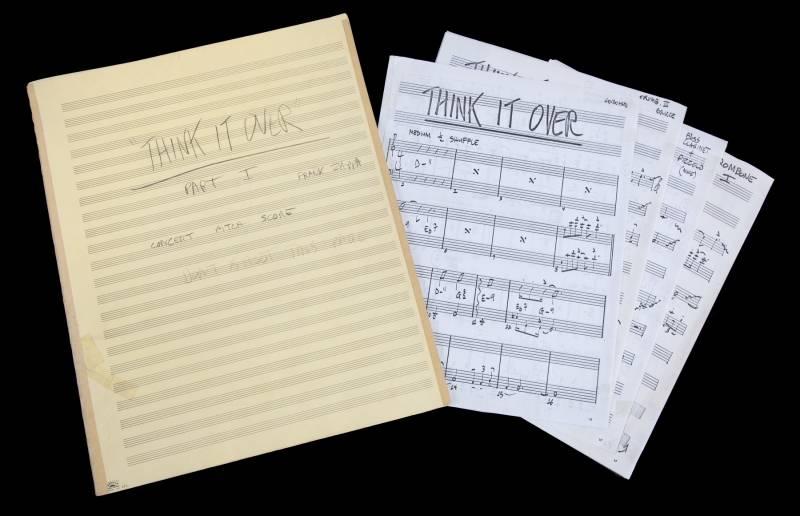
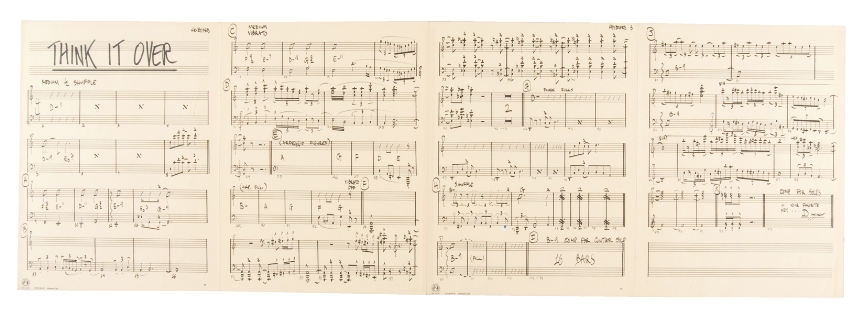
Samples from the original sheet music for "Think it over", as auctioned on internet in 2014.
Think it over, opening bars, #1 (midi file).
Think it over, opening bars, #2 (midi file).
Think it over, opening bars (transcription/score).
"Think it over" on "Joe's domage" is the predecessor of "The grand wazoo" title track, essentially the same song. As happens quite often in Zappa's output, the score and the CD versions
differ in a number of ways. The midi file "Think it over, #1" represents the literal album version of "Think it over", while #2 corresponds with the
album version combined with the keyboard score. The differences are:
- bars 1-4 of the score (bars 5-8 of the Grand wazoo example): the Grand wazoo vamp, later on used for soloing. It's
a vamp of four bars in D Dorian. The first three bars are identical, the fourth is a minor variation.
On "Joe's Domage" the chord progression is I-IV. The original score prescribes an improvised harmonic fill in, following Dm11.
On "The grand wazoo" this song begins with soloing over the vamp for over a minute.
- bars 5-8 of the score (bars 9-12 of the Grand wazoo example): on "Joe's Domage" bars 1-4 repeat almost identically. The score prescribes
a different progression, namely using the chords D-9 and Eb7. The second chord means that Zappa evades from the D Dorian scale to a scale
with four flats, thus pretty different from the Dorian scale with all notes being natural. For the midi file #2 I'm assuming that the lead melody
also plays a Db, or maybe an Eb, instead of a D, otherwise it would get dissonant. I only have page 1 of the keyboard part of the original
score in a legible size, so I can't tell for sure how the entire score goes.
- bars 9-12 of the score (bars 13-16 of the Grand wazoo example): first theme. Other than on the 1972 album release, you're here having this
song with lyrics. The bass line for the keyboard part goes a bit different from the bass guitar on "Joe's Domage", but the chords
are pretty different. The score prescribes F2add3 - Em11 - Dm11 - G2add3 - Em9, followed by Eb7 - Gm9 for bar 12. On album none of these
chords are played like that, it's a simple F - Em progression sounding in the background. Again the Eb7 chord is evasive and, for the midi file #2, again I'm
assuming the lead melody plays along with this.
- bars 13-16 of the score (bars 17-20 of the Grand wazoo example): repetition of the first theme in a different set-up. Bars 13-14 of the score, as well as
bars 17-18 and bars 25-26 of the Grand wazoo example, are the part of the first theme where you can say that it's in A minor. The melody has A as the central note
and in these bars it gets supported by an A pedal by the bass. This does not happen in the "Think it over" version on "Joe's domage". That version can hardly
by assigned to a specific scale.
Blocks A-D in the score are the four different set-ups of the first theme (bars 13-28 of the Grand wazoo example). Block E corresponds with bars 29-36 of
the Grand wazoo example. Bars 37-38 of this example represent the beginning of block F. Block I is reservated for a guitar solo, lasting 16 bars. On "Joe's Domage"
you're getting at:
Think it over, guitar solo section (midi file).
Think it over, guitar solo section (transcription).
For the live performances of 1972 the solo sections often got complemented with figures and chord progressions for the brass section. In this
case an upgoing chord progression of triads during bars 4-8. See the "D.C. Boogie" example from the next section - bars 7-9, staff 3 - for an example
of a figure. Such movements and figures were probably indicated on the spot during rehearsals, as well as the rhythm section vamps. Here it's simply D pedal.
The scale is predominantly D Dorian, as at the beginning of this composition, but D Aeolian also gets touched upon. In bar 5, beat 2, bar 7 beat 4 and bar 11, beat
three, a Bb is used. This is a recurrent feature in Zappa's music, happening too often to interpret this as incidentally altering notes.
He frequently mingles closely related scales. See the Guitar section for an overview of the clearer examples that you can find in this study.
As said above I came across the complete original score of "Think it over" in 2023, of which the title page is shown above as "Part I, concert pitch score".
The following example concerns sections G and H of this score. After the main themes have been played, the vamp gets a reprise, after which section H with
what gets called a shuffle begins. I guess the term gets used because of all the triplets, comparable to the swing rhythm of "Yo' cats" (see the Mother of prevention section).
The two bars of the shuffle get repeated three times, after which an improvised section begins. The shuffle bars are in B minor with the progression Bm7-G-A,
as also indicated in the score. The midi file contains one repetition of the shuffle bars, corresponing with 2:13 through 2:34 on the album.
Think it over, sections G and H (midi file).
The grand wazoo, 2:23-2:54 (midi file).
Think it over, sections G and H (score).
The grand wazoo, 2:23-2:54 (transcription).
The first midi file follows the score literally. At a detail level various differences with the album version can be discerned as:
- The guitar arpeggio chords from bars 44-7 aren't played on the album, nor got they replaced by other instruments.
This is also happening with the keyboard Dm11 chord from above. The total guitar arpeggio chord contains A-C-D-E-F-G over a D by the bass, thus also the Dm11 chord.
- The rhythm of bars 47 and 51 goes somewhat different (you can compare this with the example of the opening from above).
- Regarding details the shuffle gets played differently.
As also mentioned in the Waka Jawaka section, in May 2023 Jonathan Pontier sent me two of the arrangements he made for his band covering the Grand Wazoo period (image below). He also noted that the rhythm of bar
51 goes different, as well as of bar 52. So I've looked into this by trying to transcribe it from the album version rather literally and Jonathan is correct. While Zappa orginally
wrote bar 52 using only triplets very strictly, this idea was left for the album. One can also notice that there's a degree of improvisation happening during bars
52-59. The band isn't following the score note by note, nor are the three repititions of bars 52-53 identical. As an arranger Jonathan can take some liberty as well and
including improvised elements, as I usually do for my midi files, wouldn't make sense for a cover band. Zappa himself must have been using tracks from various takes and could
change the accents with his mixing panel. Section H is in B minor, with Zappa indicating the basic chord progression as Bm7-G-A.
In bar 60 a guitar solo starts, at first with the bass guitar continuing the with the figure from bar 52. From bar 64 onwards this becomes a walking bass with a keyboard
improvising the harmonies, thus the standard way of soloing in jazz.
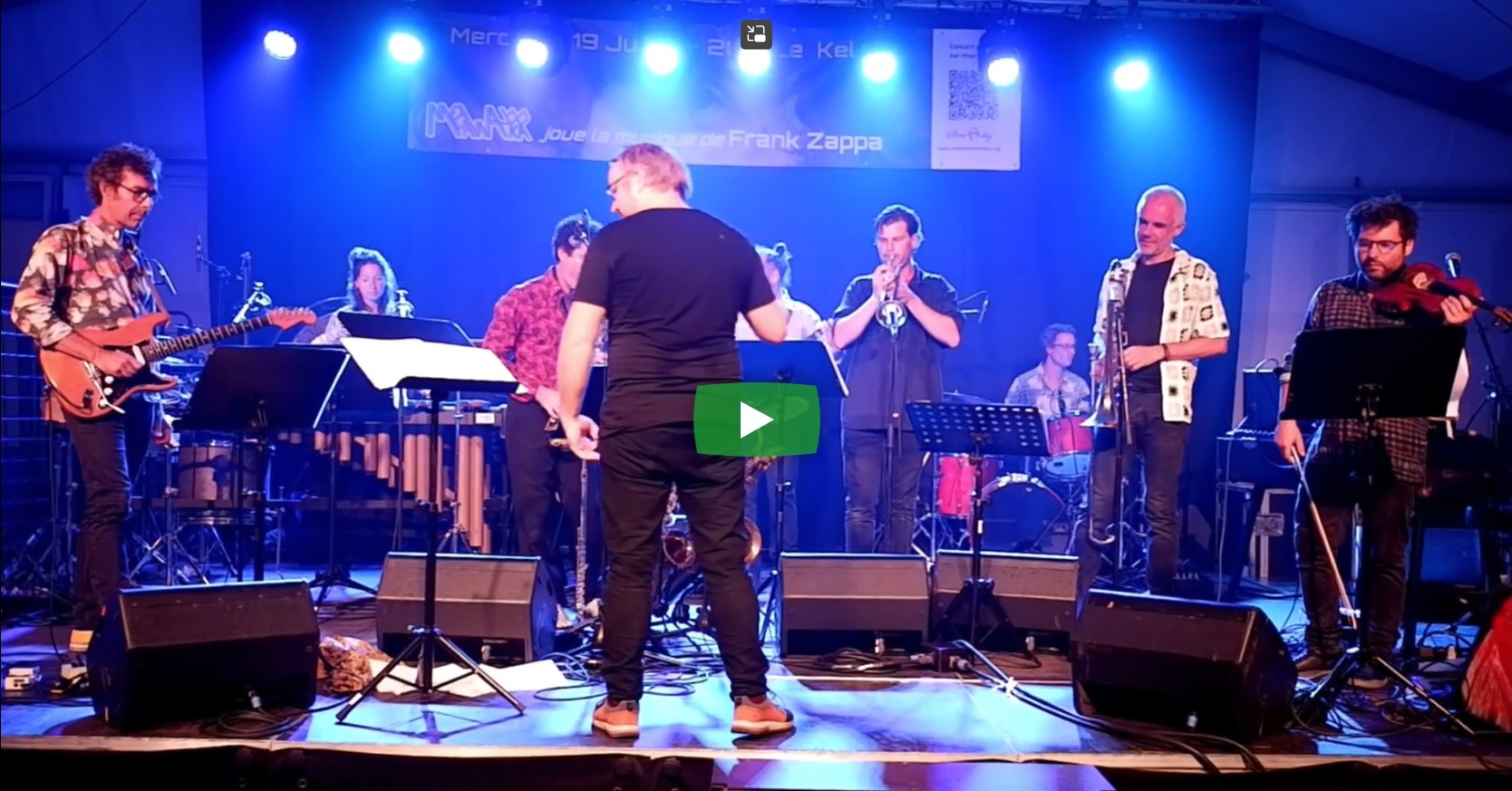
Jonathan Pontier conducting his Mega JaWooka band, July 2023.
The big band orchestra Zappa had in mind pretty much coincides with the session musicians band he managed to contract.
Three guitars, however, got replaced by one rhythm guitar, and as a compensation for it, a keyboard part got added. Version differences remain. One can also notice
that the vocal parts, that at one point existed, weren't initially prescribed, nor included during the final recordings.
So many ways to perform "The grand wazoo" are justifiable.
"The grand wazoo (1992)" also exists as a composition from 1969/1992, included in the
Outrage at Valdez section of this study. It has nothing in common with the 1972 composition from above. It features Don van Vliet, reading a part in 1969,
combined with synclavier music from around 1992. In it "the grand wazoo" gets described as being the guy from the band, wearing the weirdest hat, as
he's doing on the "Trout mask replica" album cover. This is
also different from the "Grand wazoo" booklet, where it gets described as a type of imaginary horn.
3. Cletus awreetus-awrightus
As mentioned above, transcriptions of the lead melodies from most tracks from "Waka/Jawaka" and "The grand wazoo" can be found in the Ludwig study (see the references
from the left menu). In case of "Cletus awreetus-awrightus" on pages 261-2. This lead melody suffices for exposing the structure and rhythm of the main themes.
For identifying the keys, one has at least to listen to the harmonies too, sometimes also the improvised parts. I've supplemented these melodies to a complete score for bars 1-18.
Cletus awreetus-awrightus, opening (midi file).
Cletus awreetus-awrightus, main themes (transcription).
While "Cletus awreetus-awrightus" is stable in 4/4 without rhythmic complexities, the keys are changing a number of times. The structure is one with
a multitude of themes:
- 0:00, bars 1-3. Theme one in A. Bars 1 and 3 are regularly in A, while bar 2 features quite some altered notes. The bass and brass players are
following a chord sequence: A-Bm-C#m-Dm-C#dim5-Bdim5-A.
- 0:04, bars 4-9. Theme two, a sequence of motives, nominally in G Dorian. This time the bass and brass section are playing the same melody with
parallel octaves. The harmony is formed by the keyboard parts (staves 1-2). Bar 9 is used to modulate to E Mixolydian.
- 0:12, bars 10-15. Theme three, made up of three phrases:
Bars 10-11: chord progression with the bass and descant moving in opposite directions and using different notes. The first chord, for instance,
is the D chord by the descant with an E beneath it. Combined the total harmony is Dmaj9, without the 7th.
Bars 12-13: sustained Bm chord, letting the key move over to B Dorian by switching the pedal note.
Bars 14-15: abrupt modulation to Db. Zappa applied both smooth modulations between closely related chords, sometimes with a pivot chord,
and sudden modulations like this one. It causes a surprise effect.
- 0:21, bars 16-18. Theme four, a figure of one bar in E, repeated twice.
- 0:25, bars 19-21. Theme one. The themes return, but harmonized differently.
- 0:30, bars 22-27. Theme two.
- 0:38, bars 28-31. Theme three.
- 0:44, bars 32-37. Theme five, played twice.
- 1:01: variation upon theme four.
- 1:07: playing around a chord progression, being C#-Bb-G. It's a parallel movement of three major triads, causing
modulations per chord. The scales are Mixolydian each time, but with different bass notes as keys. See also my discussion
of "The idiot bastard son" in the YCDTOSA Vol. II section for how such parallel movements can cause key changes.
- 1:29: improvisation over a I-VII alternation in E Mixolydian.
- 1:51: continuing with a I-VII alternation in C# Dorian.
- 2:02: another variation upon theme four.
- 2:07: themes 1-3 return, again in different harmonizations and with vocal parts (without words).
- 2:49: theme 4 is used as the coda for this piece. This time the final bar ends with a C# minor chord, as
if theme four should now be re-interpreted as being in C# minor.
- 2:57: end.
4. Eat that question
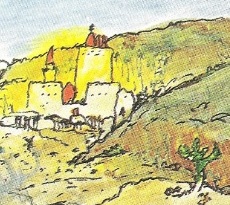 "Eat that question" from "The grand wazoo" (1972) has a central theme of four bars in E Dorian as its basis.
It introduces a keyboard solo, followed by Zappa on guitar, and it returns at the end of the song.
During this end this theme is getting played denser in phases. Between 5:43 and 6:20 you can hear:
"Eat that question" from "The grand wazoo" (1972) has a central theme of four bars in E Dorian as its basis.
It introduces a keyboard solo, followed by Zappa on guitar, and it returns at the end of the song.
During this end this theme is getting played denser in phases. Between 5:43 and 6:20 you can hear:
- 1st time: the theme is played as parallel octaves on keyboard, guitars, bass and drums, the three bottom staves of the example below.
- 2nd time: a sax joins in.
- 3th time: a sustained chord for the horn section gets added.
- 4th time: a piccolo joins in.
- 5th time: a second pulsing chord for the horn section gets added.
Undaubtely overdubbing was used to create this. In the shape of the 5th time the theme repeats three more times, while fading out.
The brass harmonies during the closing of this piece are using the notes of Dsus2
(in earlier issues of this study I called it Dmaj9, but, after relistining, there's no C# to it).
Eat that question, theme, end of the song (midi file).
Eat that question, theme, end of the song (transcription).
Before the central theme enters the picture, George Duke plays a keyboard intro without any accompaniment by others. At 0:34 the theme is to be heard
first with refined harmonies, played on two keyboards and deliberately non-synchronous, in effect a variation upon the main theme created by George Duke. In the example below, bars 1-2 are the last two bars of George Duke
improvising his own material. Bars 3-4 are a variation upon the last two bars of the main theme, bars 5-8 are a variation upon the main them in its entirety.
Normally one wouldn't say a variation upon a theme precedes the statement of this theme itself, but in this context it obviously functions as such. At 0:44 the band joins in. In 1987
the band played this piece in a similar way, though without the solos, to be found on "Make a jazz noise here".
Eat that question, 0:30-0:44 (midi file).
Eat that question, 0:30-0:44 (transcription).
The example below is the opening of the guitar solo. Like during the keyboard solo, the bass first starts varying the bass line from the main theme.
Next it turns into a I-IV alternation in E Dorian, changing the pedal note every four bars. For the opening of the guitar solo, bars 1-8 of the bass part contain
two variations upon the main theme. Bars 9-12 are upon step IV of E Dorian, an A pedal. Bars 13-14 of the example are upon the tonic again.
Eat that question, 3:17-3:41 (midi file).
Eat that question, 3:17-3:41 (transcription).
Above to the right an outtake from the background of the album cover with a little village in a desert landscape.
It's in the background of the laboratory of the evil scientist Uncle Meat, a character first
appearing in the Uncle Meat booklet.
5. Blessed relief
Like "Waka/Jawaka" from the previous section, "Blessed relief" follows a modulation scheme, in this case going as presented below. The lead melody and chords can be found in a lead sheet I encountered on the net.
It stems from a collection of jazz examples from the seventies, including three pieces by Zappa (this one, "Peaches on Regalia" and "Son of Mr. Green Genes").
Probably they were copied from lead sheets by Zappa himself (they are very accurate).
Blessed relief, lead sheet.
Left above on the lead sheet
this piece gets labeled as a "Jazz waltz" (the whole composition is in 3/4).
- 0:00 Intro. Improvisation over a I-II alternation in Bb Lydian.
- 0:27 Theme A, F major. For the last bar the E of the melody and chords from the previous three bars becomes an Eb. This goes for both
the bass pedal note and the chord. Thus an altered chord or a mingling of F major and F Mixolydian.
- 0:40 Theme B, Bb Lydian.
Blessed relief, 0:17-0:46 (midi file).
Blessed relief, 0:17-0:46 (transcription).
The actual performance of "Blessed relief" follows the lead sheet closely. The example above contains the last six bars of theme A with a trumpet
improvising a melody over the prescribed bass vamp. During the intro and themes A-B the indicated chords aren't played on any instrument in full. Instead they are loosely used
for the harmony notes, mostly played in the background on keyboards and guitar. At the second bar of theme B, bar 16 from my example, C7/Bb
is indicated in the lead sheet. Apparently the addition of Bb is done to say that the descant chord is C7 over a Bb by the bass, while in other bars the root note of the chord
is also the bass pedal. Bb is indeed the bass pedal during this bar. On the album the chords during theme B got largely skipped. During theme
C, on the other hand, chords get played as large arpeggios going up and down on keyboards irregularly.
- 0:53 Theme C, Bb Lydian.
- 0:53 Theme D, four bars in A minor/Dorian (the F/F# is absent in the examples shown here), followed by four other bars in G Dorian.
- 1:12 Block E. Solos. Every four bars the following scales alter in this following order:
F# Dorian - E major - F# Dorian - E major - A Dorian - G Dorian.
Blessed relief, 5:52-6:15 (midi file).
Blessed relief, 5:52-6:15 (transcription).
This second example is the end of the guitar solo. It contains one cycle of the modulation schedule, though without the first occurrence of the F# Dorian - E major bars.
From F# Dorian to E major is only a pedal note switch, and, if these two pedal notes were the only ones from the scheme, one could also call it a I-VII alternation in F# Dorian.
The switches to A Dorian and G Dorian are more explicit key changes, involving notes altering. On the CD leaflet, Zappa gets credited for playing lead guitar, George
Duke for keyboard and Tony Duran for rhythm guitar. At a couple of points I'm not sure who might be playing which note.
- 6:17 Themes A-D return.
Blessed relief, 6:50-7:00 (midi file, album version).
Blessed relief, 6:50-7:00 (midi file, score, without improvising).
Blessed relief, 6:50-7:00 (transcription).
This last example contains the last repetition of theme C, followed by the first two bars of theme D. Other than at the beginning, where the descant is playing a minor or major third
higher as the bass, descant and bass are playing parallel during theme C. Rather than following the prescribed notes of the chords, keyboards are improvising strings of notes.
It's all done with open pedals, giving it an unusual atmosphere. It's not really meant to be transcribed, and done by approximation, but I was interested in showing
and hearing the effect of it when comparing it with a more literal execution of the lead sheet.
- 7:10 Variations upon the intro, now used as outro.
- 8:01 End.
